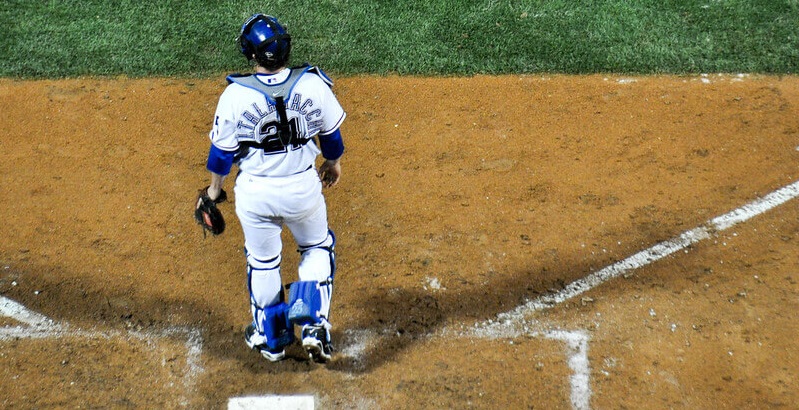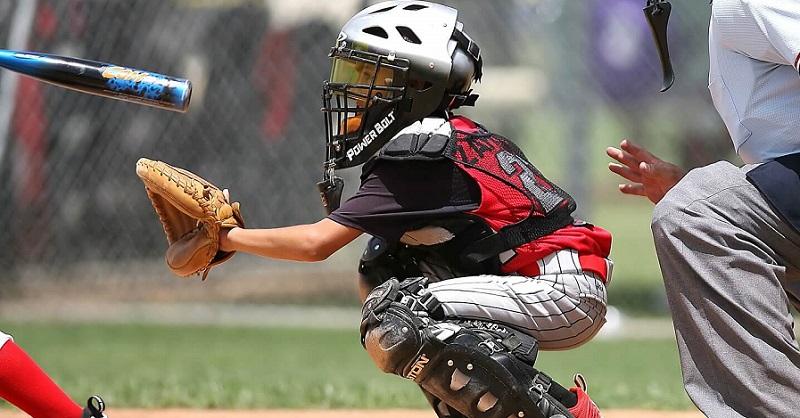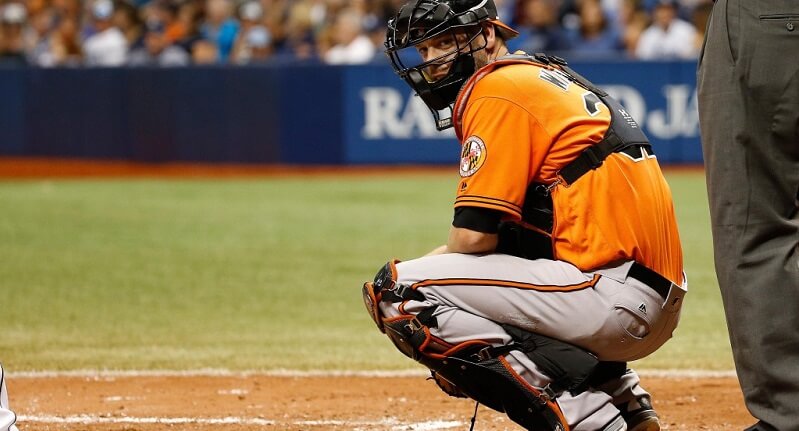Most people don’t consider the stress placed on the leg and knee areas of a catcher. However – think of all the up and down movement required for every single pitch and then multiply that for many innings, followed by many games!
It’s no wonder that many catchers experience so much knee and leg pain.
In fact Buster Posey – one of the more famous catchers of recent years – recently retired at age 34 due to the pain of the position.
Enter catchers knee savers. Many wonder if they help or are a bit more of a gimmick.
This article will address what knee savers are, how they help catchers (are they good or bad?), and if they are common. Let’s get going!
What are catcher knee savers?
Knee savers are soft pads that are placed behind the legs to help eliminate the pressure and pain that catchers experience while in the crouching position. Although the name says it all – knee savers aim to save and prolong careers by protecting important cartilage and lowering the impact bodyweight has on a catcher. This piece of equipment is completely optional and is left up to personal preference.

[blank_space height=’1em’]
Knee savers were invented by Douglas Farrago – a doctor who came up with and made the product a reality while studying in medical school. He was able to obtain a patent in 1991. Although the reception to the product was initially not so positive, it is now used by many professional and high level catchers (discussed later in this article).
The catcher is arguably the most important player on the team, besides the pitcher, and the pitcher isn’t hunched over for half the game like a catcher is.
How do Knee Savers Help a Catcher?
Now those you know the purpose – the next question you probably have is how do knee savers actually work? If you look at a pro catcher during a game, they spend most of it hunched over, with their knees out, and back bent over. If you are anything like me – I just get uncomfortable and sore thinking about it!
Pressure Relief
How a knee saver works is that they attach to the back of the shin pad. So, when the catcher is knelt down, it comfortably rests between the calf and shin – almost like a door wedge. This pad helps relieve pressure on the knees, saving the meniscus from strain and wear. It doesn’t 100% save it (nothing will), but it does relieve some the pressure and makes its safer to shoot up and make plays.
Strain Reduction
Knee saver’s also help reduce strain on the cartilage in the knees as well. Some critics do say that the wedge between the femur and tibia can be bad for players, but there is no evidence that says a knee saver can cause an injury over time.
This is a pure personal opinion, but I feel if a catcher wants to last a long time that they may want to invest in some knee savers – preferably at a younger age while strength and muscles are growing. Although I do not have any concrete evidence, I feel like more catchers are starting to wear knee savers in the MLB and NCAA baseball.
What are the best knee savers?
Now that you are familiar with what knee savers are used for and how they help – you might be interested in knowing which are your best options. This section outlines our top choices for both adults and youth catchers.
EvoShield Knee Savers


Easton is discussed a lot on this website as their catchers gear always seems to be in high demand year after year. The knee savers they offer are also often regarded with high praise within the baseball community.
As you can see in the image above, EvoShield Knee Savers feature a 4-sided design to provide more support in the crouch position for the catcher. This design is patented and therefore is unique to this particular model and brand. They also include more of a “cradle” type shape to ensure a more firm fit. This prevents the knee savers from slipping around allowing the catcher to focus on the game.
These particular knee savers are ideal for catchers who stand 5’7″ and taller.
Rawlings – Best Knee Savers for Youth Catchers


The next set of knee savers to consider are those made by Rawlings. I believe these are more suited for youth aged catchers as they provide lightweight cushioning material on the inside. As younger catchers are still growing, I didn’t want to suggest a product that was bulkier and could hinder performance.
Another great aspect of these knee savers is that they are durable and retain their shape quite well. No one wants to replace things year after year so this is a great bonus.
These particular knee savers are ideal for catchers who stand 5’6″ and shorter.
How to Put on Knee Savers
The knee saver sits in the gap between your thigh and calf when you are sitting in your catchers stance. When you are standing, it almost looks like you are wearing the boots from Iron Man or an old Astro Boy comic, but they can be an important piece of equipment that you defiantly want in your catchers bag.
In general here is how to put knee savers on:
- Remove the bottom straps on your shin guards.
- Position the knee saver behind the shin – logo facing outward (if applicable).
- Using the straps from the first step – re-attach the shin guards by first looping through the knee saver, followed by the shin guard to make a tight secure fit.
- Attach the strap to the other side of the shin guards
- If the fit is too tight, re-adjust by loosening. You want a tight fit, but not to the point where you lose circulation and blood flow!
- Crouch up and down starting slow and get faster until you are popping up. Ensure that the knee savers still feel secure.
Custom Fit Capability
The knee saver sits on the back of your leg guards on the shin straps. Depending on the model, some of them Velcro on to the back of the shin part of the leg guard, while some user another strap. To further complicate things – some players prefer to wear them lower on the pad, or higher on the pad.
The foam is designed for comfort and durability. The soft part goes on your calf, while the solid part goes on your thigh, so soft bottom, firm top. There has been no evidence to suggest wearing them higher or lower put you at risk for an injury or put stress on your knees different, it is really just down to your own personal comfort.
They also come in sizes depending on your height, so it is very important you know your height before snagging a pair of these knee saving pads.
Do Knee Savers hurt Mobility?
One big complaint is that the knee savers slightly restrict catcher mobility in that it makes running uncomfortable or awkward. Unfortunately, you can’t rip them off like you can a mask or helmet when getting ready to catch a pop-up foul ball. Once they are strapped on, they are on! There are some important factors you need to consider before buying knee savers, and typically it is easier to just go with the brand that your leg guards are.
One important thing to remember is that you definitely do not want to wear knee savers loose. Ideally, you want them nice and firm on the back of your leg and bouncing around if you needed to run. Another important thing you need to consider is that in certain brands, when you take off your leg guard the knee saver may pop off, depending on the brand you go with.

[blank_space height=’1em’]
Do Catcher Knee Savers Work?
Catchers in baseball have a problem that most of us can relate to, and that is knee problems.
Depending on the league – catchers can spend over 50 games a year hunched in a position where their ankles and knees are constantly bent. Enter the catcher knee saver, but do they actually work and do what they are intended to help with? As we know, the catcher position in baseball is the most physically demanding of all the positions in the sport so anyway to make it less demanding is a big help!
I’ve heard rumbling before that they aren’t that useful and only serve as another way to sell more equipment. Although there are never guarantees when it comes to the human body, I do believe that they help players who have had knee or leg injuries and provide much needed relief to parts of the body that are constantly bent.
The knee saver basically cancels out your body weight of the upper body coming down on the joints in the knees and ankles. It most importantly reduces pressure on the meniscus for the catchers. Pretty appropriate name for a product that can prolong your career!
Do Youth Players need Knee Savers?
I can see the case for younger players not needing them as much as they might end up getting a bit too comfortable and not experiencing the full rigor of the position. The older you get however, the more beneficial they become on your aging knees.
When I was younger, I was told by old heads to put some padding on my knee while I was working or I would pay for it when I got older, and boy do I wish I listened. Like most things, younger players don’t exactly like the look for feel of knee savers, but thankfully (as we will discuss in the next section) many pros and high level catchers are now getting on board making it easier to justify their use. For example – former Braves catcher, Kevan Smith, referred to them as pillows, and greatly helped him during his college career playing multiple double headers a season.
Do MLB players use Knee Savers?

[blank_space height=’1em’]
What is the easiest way to determine if knee savers are useful and worth it? By seeing what the professionals are doing. After all they have all the experience in the world and compete at the highest level.
Although it took a while to grasp the concept (don’t we all hate change?), many major league baseball catchers now use knee savers. Do they all? Nope – but maybe in the years to come the next generation of catching talent will all be using them.
How many MLB players use knee savers?
Ask numerous people how many pro’s wear knee savers and I’m guessing the most common answer will be very few if any at all. It’s a common misconception that MLB catchers do not wear Knee Savers, but there are a decent amount that do wear them, depending on the situation.
We mentioned former catcher Kevan Smith as being one pro who fully supports knee savers. But what about current MLB starting catchers from a recent season? I took a look at images for all MLB starting catchers from the beginning of the 2021 season. Although things change in the year – I feel like this sample should provide a sufficient starting point.
The majority of MLB catchers do not use knee savers. From my analysis only 8 of 30 currently use them – or just over 25%.
Who are some of these catchers? To me it looks like Travis D’Arnaud, Yasmani Grandal, Wilson Ramos, and Buster Posey are a few that do.
Which catchers don’t use them?
Some MLB catchers prefer not to wear them, as they feel that it hinders their movements and that it doesn’t allow them to fully utilize their leg muscles. The restriction in movement typically comes while running, and some MLB pitchers prefer to not have any restriction in motion. Otherwise, MLB catchers do typically wear them, especially in the more busy parts of the season where they are doing double headers on occasion.
It really seems like if a catcher wears them is entirely situational. They are constantly putting stress on their legs and knees especially. So, players with reoccurring knee problems, probably will wear a knee saver more often than a younger player. Typically, older players wear them as well, trying to prolong their career and you know, not have knee issues. The main reason for wearing a knee saver is to prevent injury and stop from reagitating old injuries.
Some of the more prominent catchers that do not wear knee savers include: Willson Contreras, Salvador Perez, JT Realmuto, and Yadier Molina.
Conclusion on Knee Savers
Helmet, mitt, leg guards, chest protector, and knee savers? The first four are absolutely mandatory, but what about knee savers? Well, it depends on your personal preference. Some catchers prefer to have knee savers, as they tend to relieve the stress on your knee joints, cartilage, and meniscus. Probably the second most important part of the catchers body after their hands.
We hope that this article has helped you to figure out whether or not knee savers would be helpful for you in your specific situation. A lot of the choice comes down to personal preference and how good (or bad) your knees and leg feel. Although there are some that believe that knee savers provide a catcher with an additional “freshness” advantage – I do believe the long term benefits on your body outside of the game far outweigh the concerns of others!